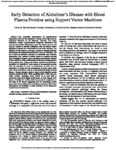Early Detection of Alzheimer's Disease with Blood Plasma Proteins Using Support Vector Machines
| dc.contributor.author | Eke, Chima | |
| dc.contributor.author | Jammeh, Emmanuel | |
| dc.contributor.author | khazaeli, Shahab | |
| dc.contributor.author | Carroll, Camille | |
| dc.contributor.author | Pearson, Stephen | |
| dc.contributor.author | Ifeachor, Emmanuel | |
| dc.date.accessioned | 2021-08-09T12:31:13Z | |
| dc.date.available | 2021-08-09T12:31:13Z | |
| dc.date.issued | 2021-01 | |
| dc.identifier.issn | 2168-2194 | |
| dc.identifier.issn | 2168-2208 | |
| dc.identifier.other | 1 | |
| dc.identifier.uri | http://hdl.handle.net/10026.1/17491 | |
| dc.description.abstract |
The successful development of amyloid-based biomarkers and tests for Alzheimer's disease (AD) represents an important milestone in AD diagnosis. However, two major limitations remain. Amyloid-based diagnostic biomarkers and tests provide limited information about the disease process and they are unable to identify individuals with the disease before significant amyloid-beta accumulation in the brain develops. The objective in this study is to develop a method to identify potential blood-based non-amyloid biomarkers for early AD detection. The use of blood is attractive because it is accessible and relatively inexpensive. Our method is mainly based on machine learning (ML) techniques (support vector machines in particular) because of their ability to create multivariable models by learning patterns from complex data. Using novel feature selection and evaluation modalities, we identified 5 novel panels of non-amyloid proteins with the potential to serve as biomarkers of early AD. In particular, we found that the combination of A2M, ApoE, BNP, Eot3, RAGE and SGOT may be a key biomarker profile of early disease. Disease detection models based on the identified panels achieved sensitivity (SN) > 80%, specificity (SP) > 70%, and area under receiver operating curve (AUC) of at least 0.80 at prodromal stage (with higher performance at later stages) of the disease. Existing ML models performed poorly in comparison at this stage of the disease, suggesting that the underlying protein panels may not be suitable for early disease detection. Our results demonstrate the feasibility of early detection of AD using non-amyloid based biomarkers. | |
| dc.format.extent | 218-226 | |
| dc.format.medium | Print-Electronic | |
| dc.language | eng | |
| dc.language.iso | eng | |
| dc.publisher | Institute of Electrical and Electronics Engineers (IEEE) | |
| dc.subject | Biomarkers | |
| dc.subject | Proteins | |
| dc.subject | Blood | |
| dc.subject | Biological system modeling | |
| dc.subject | Dementia | |
| dc.subject | Support vector machines | |
| dc.subject | Alzheimer's disease | |
| dc.subject | blood biomarker | |
| dc.subject | dementia | |
| dc.subject | machine learning | |
| dc.subject | support vector machine | |
| dc.title | Early Detection of Alzheimer's Disease with Blood Plasma Proteins Using Support Vector Machines | |
| dc.type | journal-article | |
| dc.type | Journal Article | |
| dc.type | Research Support, N.I.H., Extramural | |
| dc.type | Research Support, Non-U.S. Gov't | |
| dc.type | Research Support, U.S. Gov't, Non-P.H.S. | |
| plymouth.author-url | https://www.webofscience.com/api/gateway?GWVersion=2&SrcApp=PARTNER_APP&SrcAuth=LinksAMR&KeyUT=WOS:000641705100022&DestLinkType=FullRecord&DestApp=ALL_WOS&UsrCustomerID=11bb513d99f797142bcfeffcc58ea008 | |
| plymouth.issue | 1 | |
| plymouth.volume | 25 | |
| plymouth.publication-status | Published | |
| plymouth.journal | IEEE Journal of Biomedical and Health Informatics | |
| dc.identifier.doi | 10.1109/jbhi.2020.2984355 | |
| plymouth.organisational-group | /Plymouth | |
| plymouth.organisational-group | /Plymouth/Faculty of Health | |
| plymouth.organisational-group | /Plymouth/Faculty of Health/Peninsula Medical School | |
| plymouth.organisational-group | /Plymouth/Faculty of Science and Engineering | |
| plymouth.organisational-group | /Plymouth/Faculty of Science and Engineering/School of Engineering, Computing and Mathematics | |
| plymouth.organisational-group | /Plymouth/REF 2021 Researchers by UoA | |
| plymouth.organisational-group | /Plymouth/REF 2021 Researchers by UoA/UoA03 Allied Health Professions, Dentistry, Nursing and Pharmacy | |
| plymouth.organisational-group | /Plymouth/REF 2021 Researchers by UoA/UoA12 Engineering | |
| plymouth.organisational-group | /Plymouth/Research Groups | |
| plymouth.organisational-group | /Plymouth/Research Groups/FoH - Applied Parkinson's Research | |
| plymouth.organisational-group | /Plymouth/Research Groups/FoH - Community and Primary Care | |
| plymouth.organisational-group | /Plymouth/Research Groups/Institute of Translational and Stratified Medicine (ITSMED) | |
| plymouth.organisational-group | /Plymouth/Research Groups/Institute of Translational and Stratified Medicine (ITSMED)/CCT&PS | |
| plymouth.organisational-group | /Plymouth/Research Groups/Plymouth Institute of Health and Care Research (PIHR) | |
| plymouth.organisational-group | /Plymouth/Users by role | |
| plymouth.organisational-group | /Plymouth/Users by role/Academics | |
| plymouth.organisational-group | /Plymouth/Users by role/Researchers in ResearchFish submission | |
| dc.publisher.place | United States | |
| dc.identifier.eissn | 2168-2208 | |
| dc.rights.embargoperiod | Not known | |
| rioxxterms.funder | EPSRC | |
| rioxxterms.identifier.project | Novel Point-of-Care Diagnostic Techniques for Dementia | |
| rioxxterms.versionofrecord | 10.1109/jbhi.2020.2984355 | |
| rioxxterms.licenseref.uri | http://www.rioxx.net/licenses/all-rights-reserved | |
| rioxxterms.type | Journal Article/Review | |
| plymouth.funder | Novel Point-of-Care Diagnostic Techniques for Dementia::EPSRC |


